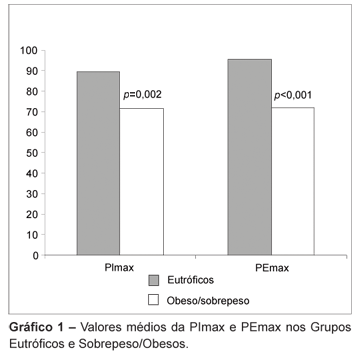OBJECTIVE: Evaluate respiratory muscle strength in overweight/obese children and adolescents. METHODS: This cross-sectional study enrolled patients between four and 15 years old, classified according to the National Center for Health Statistics curve for body mass index (BMI): Overweight/Obese Group (OG, BMI> 85th percentile) and Normal Weight Group (NG, BMI between 5th and 85th percentile). Manuvacuometer was used to measure maximal inspiratory pressure (MaxInspP) and maximal expiratory pressure (MaxExpP). Three measurements were obtained using the maximum pulmonary effort and the higher value was considered. Variables were compared by t test chi-square test. Adjustment of possible covariants was made by analysis of covariance, being significant p<0.05. RESULTS: 69 children were included: 37 (54%) in the OG and 32 (46%) in the NG. Obese patients were younger: 9.8±2.3 versus 10.9±1.9 years (p=0.031). MaxInspP was 71.4±24.9cmH2O in the OG and 89.6±19.6cmH2O (p=0.002). MaxExpP was 71.9±24.8cmH2O in the OG and 95.6±19.6cmH2O in the NG (p<0.001). There was no difference between groups regarding gender and physical activity. After adjustment for age, only the MaxExpP was significantly different between groups (p=0.003). CONCLUSIONS: Maximal expiratory pressure was lower in overweight/obese patients, indicating that obesity may alter pulmonary mechanics.
overweight; obesity; muscle strength; lung; child


